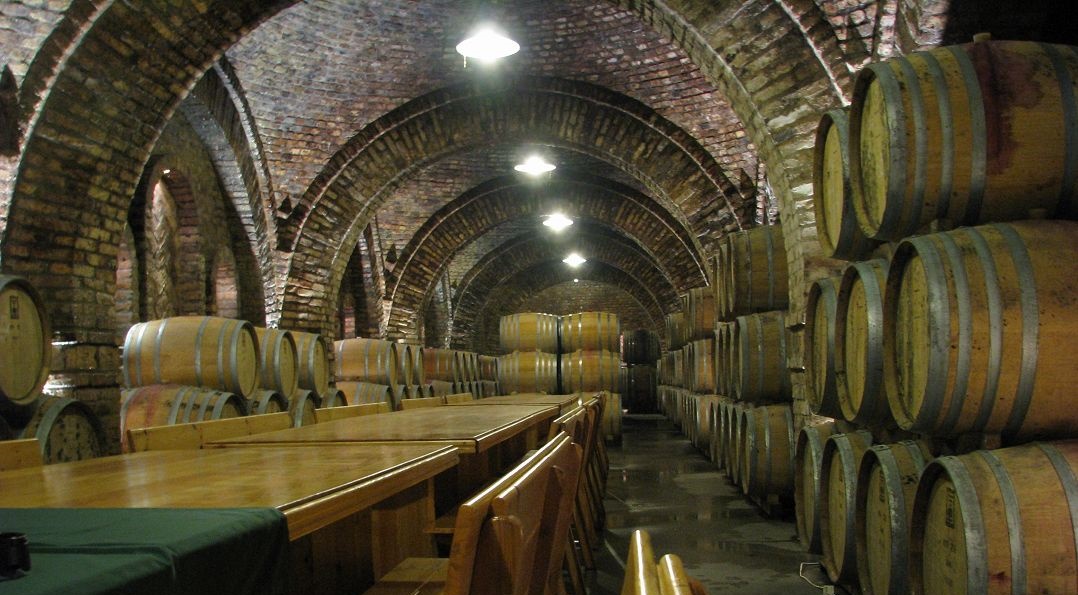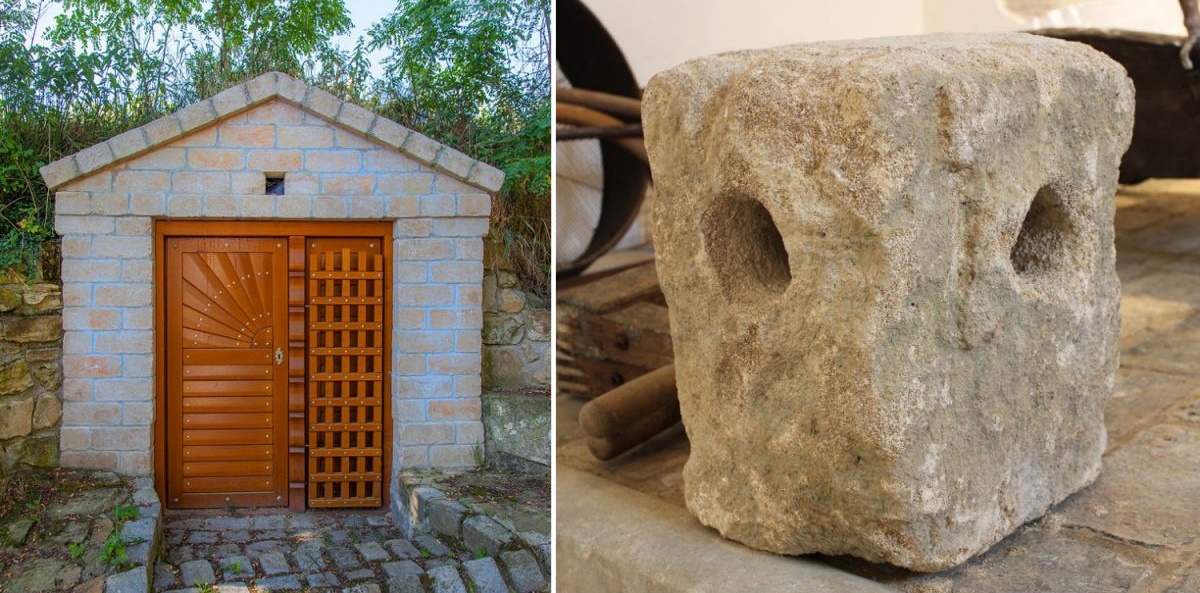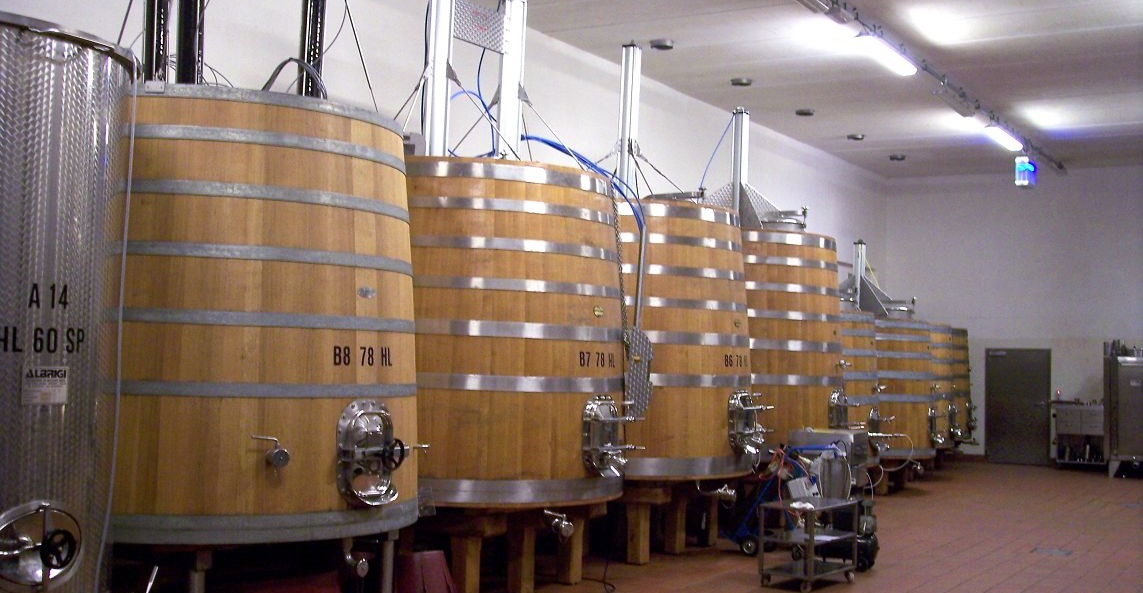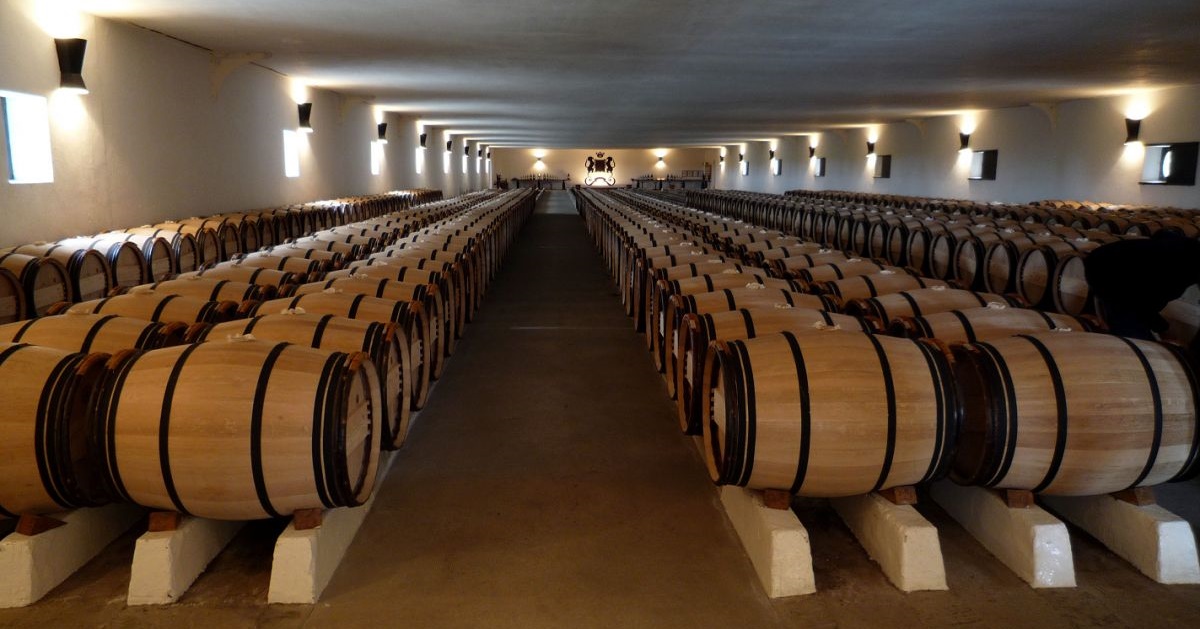Common name for the place where wine is usually stored in bottles or other containers. In the original sense, this refers to an underground room, but the term also applies to a ground-level arrangement. A winery, on the other hand, usually refers to a production facility that, unlike an independent winery, does not have its own vineyards and processes grapes supplied by grape producers, as is the case with winegrowers' cooperatives or other processing associations, for example. However, the term "Kellerei" is also used to describe a specialised wine shop (vinotheque).
Cellar lane
The old wine cellars, which were generally dug below ground level, were usually lined up next to each other outside the actual wine-growing community in the so-called Kellergasse (cellar alley) and created a typical picture. In front of the actual wine cellar was the press house, where the grapes delivered after the harvest were pressed. The press house was connected to the cellar tube, the actual storage cellar, via the cellar neck. The dark cellar mould (also known as cellar cat) often found in such cellars was or is desirable.

The picture on the left shows a cellar pipe, the picture on the right a press house in the cellar alley in the municipality of Prellenkirchen(Lower Austria).
Fermentation cellar
Fermentation produces fermentation gas (carbon dioxide), which is toxic to humans. In the past, the extremely unsafe method of candle testing was used to determine the level of gas present. The gas used to be removed via two structural devices. These were the fermentation grid in the cellar door and the vapour pipe (ventilation shaft). Both are only suitable to a limited extent because the carbon dioxide is heavier than air and collects at the bottom or at the lowest point. Today, it is extracted via exhausters (ventilators) and fed into the open air or, in large cellars, into containers and utilised. The picture shows a typical vaulted cellar. This does not have a flat ceiling, but is usually closed off by a barrel vault with two parallel abutments of equal length.

The picture shows an old vaulted cellar with a cross-ribbed vault for barrel ageing and wine storage.
Characteristics
A good wine cellar (summer and winter) has a temperature of around 8 to 12 °C (which is also the ideal wine temperature for most white wines) and a humidity of 70 to 80%. The ideal temperature should be as constant as possible; strong fluctuations are far more harmful than slightly higher temperatures that remain constant over a longer period of time. From around 20 to 25 °Celsius it becomes problematic, as heat accelerates all chemical processes.
Uncontrolled warm storage is the most common cause of undesirable, premature ageing of wines. Among other things, this destroys the fruit flavours. The cork moth, which likes to lay its eggs in damp places such as corks, is another possible source of defects. The hatched caterpillars can eat corks and cause them to leak, which can lead to oxidation and, in the worst case, spoilage of the wine.

The picture on the left shows a fermentation grille in the cellar door and the picture on the right shows a roof pipe at the end of the vapour pipe.
Bottle storage
A wine cellar should be dark and well ventilated, but free from draughts and vibrations. The bottles should be stored horizontally so that the cork is always wetted by the liquid and does not dry out. However, there are now studies that suggest upright storage if there is sufficient humidity. Champagne or sparkling wine is often stored upright, as are Madeira, port, sherry and similar wines. The reason for this is that carbon dioxide (in the case of sparkling wines) or a high alcohol content could damage the cork and thus cause an oxidative process. An undamaged cork has a positive effect on the shelf life.

The picture shows some large-volume wooden tanks in which temperature-controlled fermentation is carried out.
Wine cellar management
There are two important criteria with regard to racking. Firstly, the bottles must be easy to remove. It should be possible to remove as few bottles as possible, or at best none at all, in order to reach the desired one. Furthermore, appropriate labelling must be possible for the attachment of codes for a management system. In order to maintain an overview, a wine cellar management system on paper or a PC programme is required above a certain quantity (30 bottles). A wine climate control cabinet can also be useful in the wine cellar. Every producer, trader and processor of wine must keep a cellar log of the activities in the wine cellar.
Treasure chamber
Many wineries store exquisite, valuable wines and wine rarities from old, special vintages in their own cellar area - the treasure chamber. Such wines are also known as treasury wines or crescendos, although this has no legal significance in wine law.
Cellar law
In a wine cellar, cellar law must be observed. This is often humorously displayed on signs, often in rhyming form. It is sacrilege to knock on barrels to determine the fill level.

The picture shows a barrique cellar at Château Mouton-Rothschild in the commune of Pauillac in the Médoc(Bordeaux).
Further information
See also under winegrowing customs, bottle ageing, wine enjoyment and wine temperature. For the production of alcoholic beverages, see Champagne (sparkling wines), distillation (distillates), speciality wines, spirits (types), winemaking (wines and wine types) and wine law (wine law issues).
Kellerröhre: by Weinviertel Tourismus - Wurnig
Cellar alley: by Egon Mark
Vaulted cellar: by nattynati on Pixabay
Fermentation grid: by Architektur Fotografie Wien - Romana Fürnkranz
Roof pipe: by Weinviertel Tourismus - Krönigsberger
Fermentation tanks: from tatlin on Pixabay
Mouton-Rothschild: By MPW57 - Own work, Public domain, Link
William Koch wine cellar: Courtesy Sotheby's
Voices of our members

For my many years of work as an editor with a wine and culinary focus, I always like to inform myself about special questions at Wine lexicon. Spontaneous reading and following links often leads to exciting discoveries in the wide world of wine.
Dr. Christa Hanten
Fachjournalistin, Lektorin und Verkosterin, Wien